Buying a new mini guitar amp, just like any other piece of gear, can be a lot of fun. The experience of going to guitar shops, watching videos, and reading articles can be a good experience if you’re getting accurate information.
All this is even more interesting when you know what you are looking for in an amplifier. Once you know what you’re looking for, all that’s left to do is compare specs and listen to what others in the industry are saying about different models.
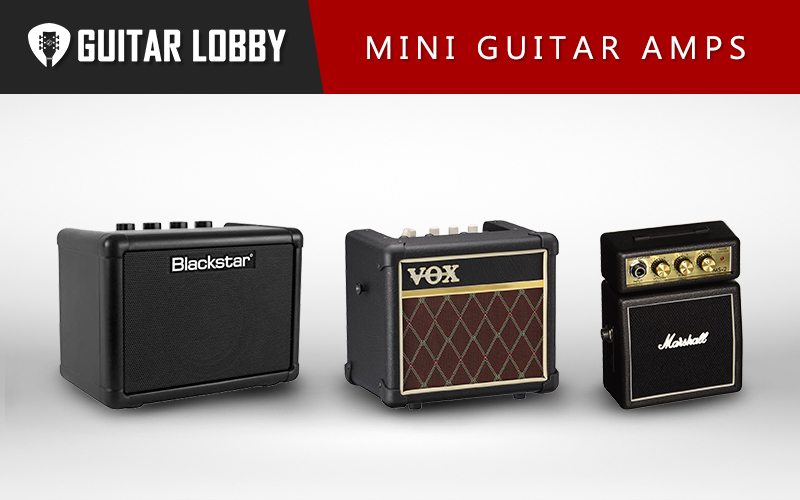
I’ll start this article by jumping straight into reviews on the best mini guitar amps at each price point, but if you want to learn more about them before reading reviews check out our buying guide at the bottom of the page.
| Name of Product | Image of Product | Description | Price Range | Full Review |
|---|---|---|---|---|
| 1. Yamaha THR5 (Best Overall) | 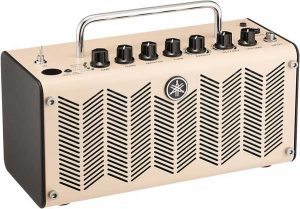 | Speaker: 2x3" Power: 10W | $200 | Read Full Review Below |
| 2. Roland Micro Cube (Editor's Choice) | 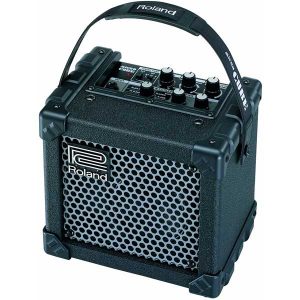 | Speaker: 1x5” Power: 3W | $150 | Read Full Review Below |
| 3. Vox Mini 3 G2 (Best Value) | 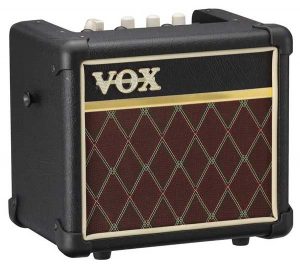 | Speaker: 1x5" Power: 3W | $150 | Read Full Review Below |
| 4. Boss Katana Mini Combo (Best Under $100) | 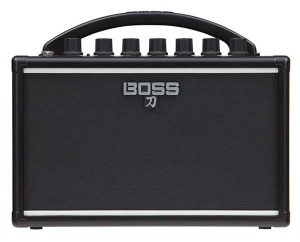 | Speaker: 1x4" Power: 7W | $100 | Read Full Review Below |
| 5. Blackstar Fly 3 (Budget Pick) | 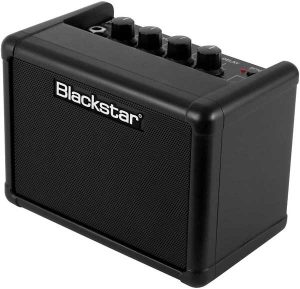 | Speaker: 1x3" Power: 3W | $55 | Read Full Review Below |
| 6. Marshall MS2 (Best Micro) | 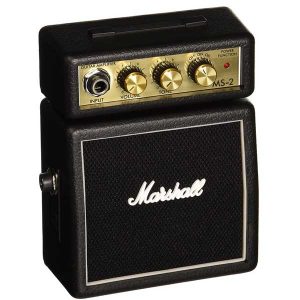 | Speaker: 1x2" Power: 1W | $55 | Read Full Review Below |
| 7. Fender Frontman 10G | 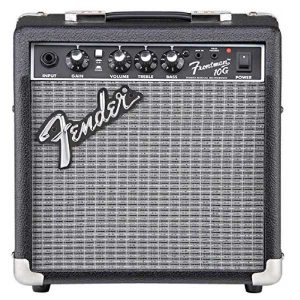 | Speaker: 1x6" Power: 10W | $70 | Read Full Review Below |
| 8. Laney Mini Lion | 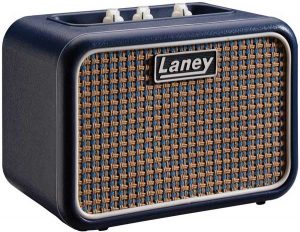 | Speaker: 1x3” Power: 3W | $65 | Read Full Review Below |
| 9. Orange Crush Mini | 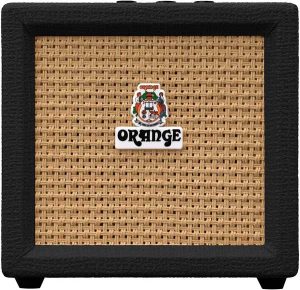 | Speaker: 1x4” Power: 3W | $70 | Read Full Review Below |
| 10. Monoprice 611705 (Best Mini Tube Amp) | 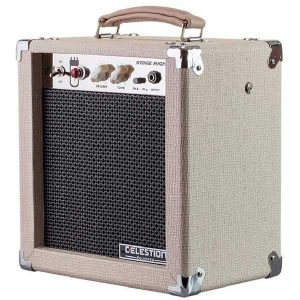 | Speaker: 1x8” Celestion Custom speaker Power: 5W | $115 | Read Full Review Below |
| 11. Danelectro N-10 Honeytone (Cheapest Mini Amp) | 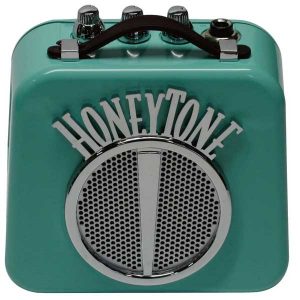 | Speaker: 1x2” Power: 1W | $25 | Read Full Review Below |
| 12. Vox Pathfinder 10 | 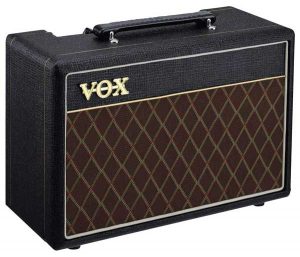 | Speaker: 1x6.5” Vox Bulldog speaker Power: 10W | $150 | Read Full Review Below |
| 13. Marshall MG10 | 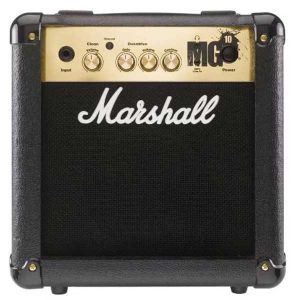 | Speaker: 1x6.5” Power: 10W | $110 | Read Full Review Below |
| 14. Vox Amplug 2 AC30 | 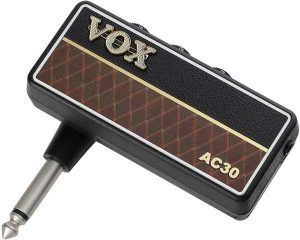 | Type and Power Supply: 2xAA batteries | $45 | Read Full Review Below |
| 15. Harley Benton Rockplug | 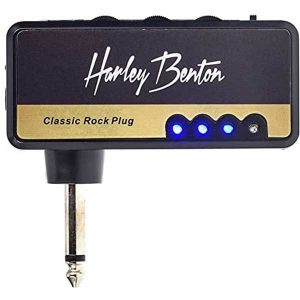 | Type and Power Supply: Built-in rechargeable battery | $15 | Read Full Review Below |
| 16. ZT Lunchbox Junior | 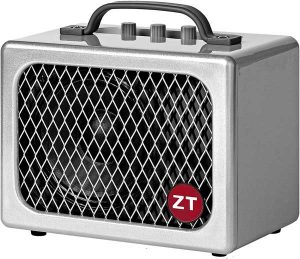 | Speaker: 5” ZT custom speaker Power: 35W | $200 | Read Full Review Below |
| 17. Roland Mobile Cube | 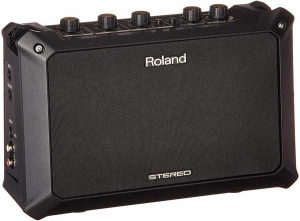 | Speaker: 2x4” Power: 5W | $180 | Read Full Review Below |
Here Are the Best Mini Guitar Amps
1. Yamaha THR5 (Best Overall)
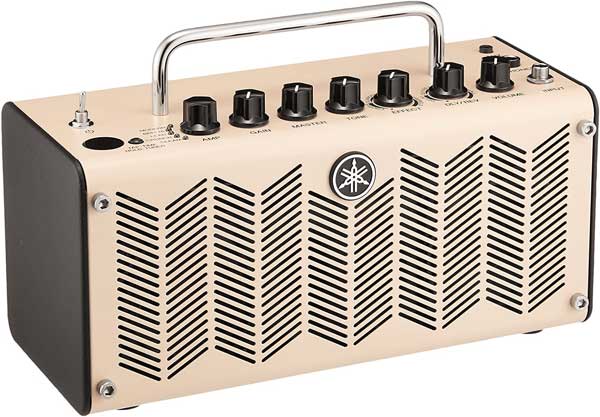
| Estimated Price | $200 |
| Dimensions | 271 x 167 x 120 mm, 2 kg |
| Speaker | 2×3″ |
| Output Power | 10W |
| Type and Power Supply | Digital, AC adapter or 8xAA batteries |
| Input/Output | Instrumental jack, aux, headphone, USB output |
| Knob Panel | Tuner, amp, gain, master, tone, effect, delay/reverb, volume |
My Review: If you are a guitarist who composes and records, but also travels constantly, this Yamaha amp is ideal for you. This is one of the most powerful mini amps on this list thanks to the 2×3″ speakers with a total power of 10W. Although quite powerful, the dimensions are small, 271x 167x 120 mm, and weighs 2 kg. This is a digital amplifier that offers many effects and preamps that I will talk about in more detail below. But first, let’s mention the power supply options.
Like other mini amps in this review, the THR has two options: an AC adapter or 8xAA batteries depending on how you use it. The downside with the batteries is that due to the power of the amp, they do not last long, about 8h. So batteries are not a good option for practicing or recording. This means if you are at home or have the option to use the AC adapter, you are going to want to use the AC adapter. For any outdoor occasion, the batteries will do the job for you.
When it comes to the inputs, you have the standard features, the instrumental jack, and the aux.
But with the outputs, other than the headphones, there is also a USB port that connects to a computer. With the amp, there is also a complimentary copy of Cubase AI in which is a great software to record in. Imagine a scenario where you travel and carry a laptop, headphones, and a Yamaha THR5 amp. Nothing can stop you from recording the latest material that comes into your head.
To all of this you can add 5 different preamps: Clean, Crunch, Lead, Brit Hi, and Modern as well as the most famous and most used effects: Chorus, Flanger, Phaser, Tremolo, Delay, and Reverb. All in all, I would say this is the best mini guitar amp out there right now that’s reasonably priced.
2. Roland Micro Cube (Editor’s Choice)
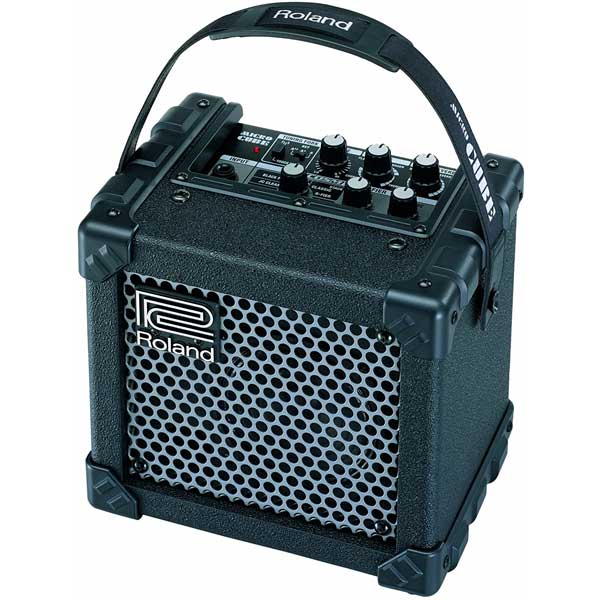
| Estimated Price | $150 |
| Dimensions | 227 x 247 x 172 mm, 2.7 mg |
| Speaker | 1×5” |
| Output Power | 3W |
| Type and Power Supply | Digital, DC adapter, 6 AA batteries |
| Input/Output | Instrumental jack, I-Cube link, headphone/rec. output |
| Knob Panel | Gain, volume, tone, master, amp type, EFX, delay/reverb, tuner |
My Review: The Roland Micro Cube is the real deal when it comes to mini amps. It may not be the most compact amp in this category but it definitely has everything a modern guitarist needs. With dimensions of 227 x 247 x 172 mm and a weight of only 2.7 kg, it is a highly portable amp for practicing at home but also for playing outdoors. The amp is powered by 6 AA batteries or DC adapter.
This is a modeling/digital amp so there are a bunch of preamps and effects on it. Plus it comes with an extra perk, an original feature for this amp, the I-Cube link. This connects the amp to any iOS device to help you enrich your practice session and gives you the option to record the music you play. There are several free guitar apps for jamming, learning, and recording that are compatible with the Roland Micro Cube.
The guitar connects to the instrumental jack, and in addition to the I-Cube link, there is another output for headphones or recording. And the most interesting part of any amp, the knob panel.
Here the knob panel is divided into two groups, one of which contains the most basic settings: gain, volume, tone, and master. The other group of knobs is for choosing one of the 8 amp models, adding effects (chorus, flanger, phaser, tremolo, and octave) and the delay/reverb knob. And to the right of the knob panel is the tuner.
What is rare with this type of amps is the holding strap. This makes the amp easy to carry around. The only real limitation is that it only with iOS devices. Everything else is top-notch.
3. Vox Mini 3 G2 (Best Value)
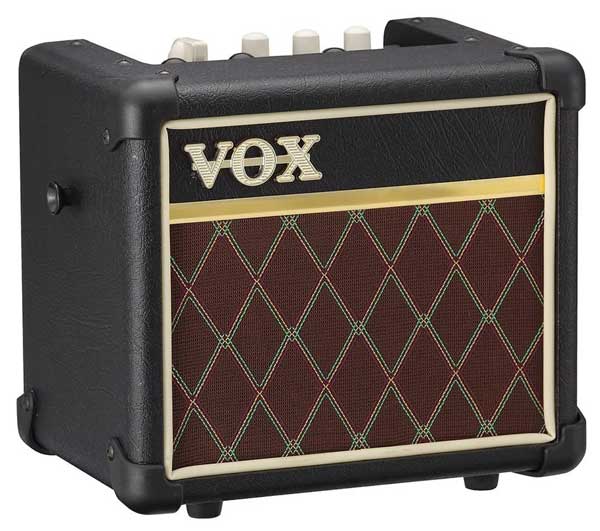
| Estimated Price | $150 |
| Dimensions | 262 x 174 x 223 mm, 3.0 kg |
| Speaker | 1×5″ |
| Output Power | 3W |
| Type and Power Supply | Digital, AC adapter or batteries |
| Input/Output | Instrumental jack, microphone jack, aux jack, headphone output |
| Knob Panel | Amp, gain, tone, volume, effects, delay/reverb, tuner |
My Review: The Vox Mini 3 G2 is a compact, lightweight, and portable mini amp with a classic look. This makes it ideal for anyone on the go who wants to be able to spend more time practicing guitar wherever they are. It has 1×5″ speakers with 3W output power. There are two power supply options, an AC adapter or 6 AA batteries that last up to 12h.
On the control panel, you will find the standard (1/4) instrumental input. Next to it here are the microphone and the aux input for playing songs or backing tracks. There is also a headphone output. This can be handy because it allows you to play at any time without being too loud for your family or neighbors.
This amp is digital which means that you can choose between 11 different amps and 12 most used effects including a compressor, chorus, flanger, tremolo, different types of reverb, and delay on tap. And what makes this mini amp complete for practicing is the tuner.
Popular Related Article: The 14 Best Wireless Guitar Systems
4. Boss Katana mini combo (Best Under $100)
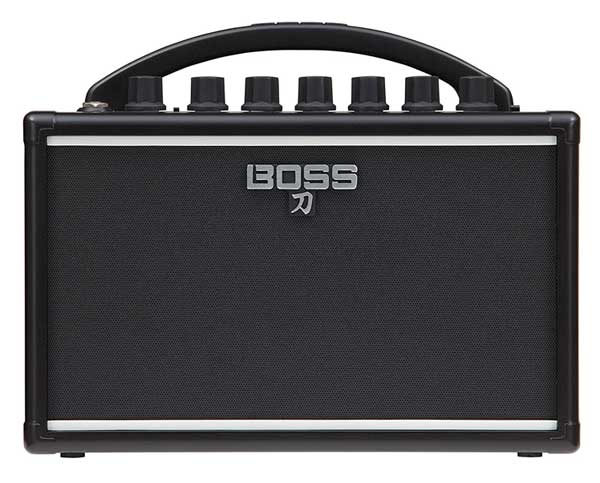
| Estimated Price | $100 |
| Dimensions | 230 x 181 x 116 mm, 1.2 kg |
| Speaker | 1×4″ |
| Output Power | 7W |
| Type and Power Supply | Solid state, DC adapter or 6 x AA batteries |
| Input/Output | Instrumental jack, aux input, headphone/rec. output |
| Knob Panel | Gain, volume, EQ (bass, middle, treble), delay (time, level), power button |
My Review: If you are anything like me, you are probably not used to hearing Boss in context to a guitar amp, are you? But not only does it produce amplifiers, Boss has come out with a great “katana” series with different dimensions and power, but also with great performance and features.
Like (almost) all amps on this “mini” list, the Boss Katana amp has small dimensions of 230 x181 x116 mm and weighs only 1.2 kg. Surprisingly, this small size amp is packed with a 1×4″ speaker with the power of 7W. This is loud enough to be used in any environment although I would definitely not recommend it for band rehearsals.
The Boss Katana mini combo is a solid state amp that can operate on an adapter (DC) or batteries (6 x AA). It has two inputs, one instrumental and one aux. What is interesting is that besides the standard headphone output, the Boss Katana mini combo also has a recording output. This feature gives it a huge advantage over its competitors.
It is a USB output that connects the amp to your computer. It can be used as a recording insert to record music in a recording program. This gives a well-balanced clean and overdrive so you don’t need to make any adjustments in the recording program itself. On the knob panel are the gain, volume, EQ, and delay panels, and on the right is the power button.
Unlike other amps where the delay is set with a tap button, here the delay is adjusted via two knobs, time and volume, which in my opinion is much easier to use. All in all, I would say this is the best mini guitar amplifier under $100.
5. Blackstar Fly 3 (Budget Pick)
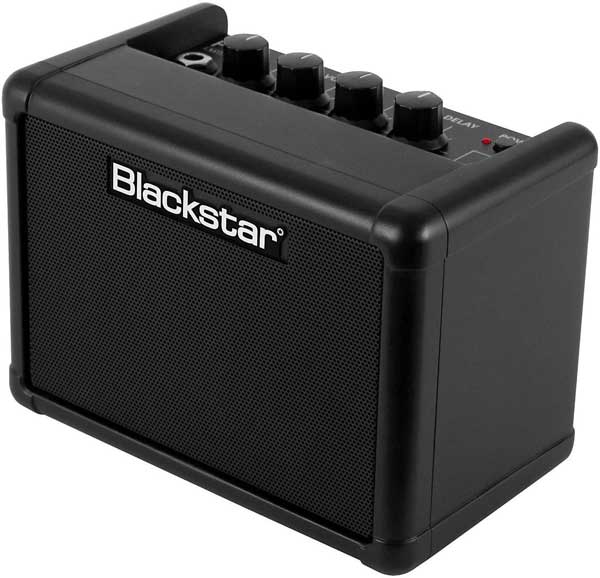
| Estimated Price | $55 |
| Dimensions | 170 x 126 x 102 mm, 0.9 kg |
| Speaker | 1×3″ |
| Output Power | 3W |
| Type and Power Supply | Analog, DC adapter or battery |
| Input/Output | Instrumental jack, MP3 line-input, headphones output, 1xRJ45 jack extension speaker output |
| Knob Panel | Gain, volume, equalizer/ISF, tap to delay, power button |
My Review: Blackstar is a guitar amp manufacturer that has made tremendous progress in the last few years. This is thanks to a group of ex-Marshall engineers who are really well versed in the art of making guitar amps.
This amp has a phenomenal design that, to be fair, can be said for all Blackstar models. What makes the “Fly 3″ a mini amp are its dimensions, of course. With a size of 170 x 126 x 102 millimeters and a weight of less than one kg (0.9).
The body of this amp houses a 1×3” speaker that produces 3W of output power. According to the dimensions and its power, this is an ideal portable mini guitar amp. Next to the instrumental jack for the guitar, there is also a line-input for practicing with backing tracks or simply for playing music. And, of course, the inevitable part of this type of amps is the headphone jack which is very useful when it comes to practicing in any environment.
The knob panel is very simple and created from only four knobs which looking from left to right are gain, volume, EQ / ISF, and delay. The first, second, and fourth knobs are probably already familiar to you. But let’s focus on the third one because it is something that only exists in the Blackstar amps, and that is the ISF. This is a very interesting and innovative feature that is a characteristic of the Blackstar amps, the Infinite Shape Feature, or IFS.
By simply turning this knob clockwise, you can choose between two types of amp sound, American or British. The difference between them is that the American style sounds tight, focused, percussive response, and the British sounds woody, crunchy, and warm.
This technology in this analog amp is a great replacement for the preset in the digital amps (selecting different types of guitar models).
Related Article: Recommended Guitar Amps (All Price Ranges)
6. Marshall MS2 (Best Micro)
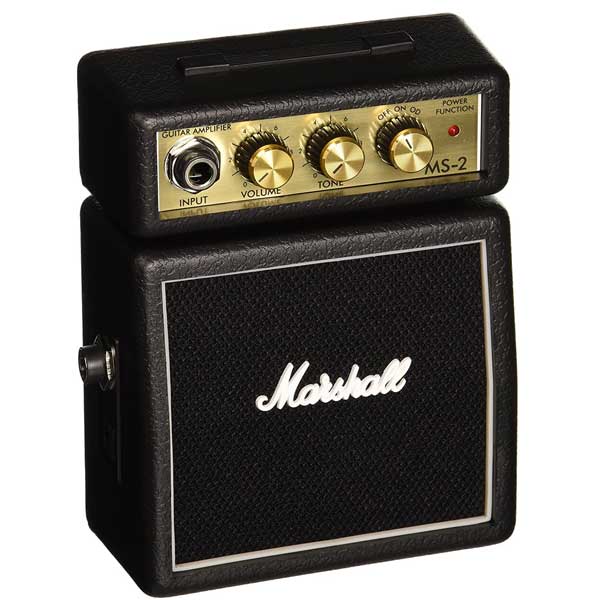
| Estimated Price | $55 |
| Dimensions | 110 x 140 x 60 mm, 0.34 kg |
| Speaker | 1×2″ |
| Output Power | 1W |
| Type and Power Supply | Solid state, AC adapter or 9V battery |
| Input/Output | Instrumental jack, headphone output |
| Knob Panel | Volume, gain, on/voice/overdrive |
My Review: If you want to have a guitar amp with you every time you leave the house, the Marshall MS2 is a great option. This is the smallest solid-state guitar amp you can find on the market. Its dimensions of 110 x 140 x 60 mm and weight of only 0.34kg make this amp very portable.
However, its tiny body houses a 1×2 ‘speaker, and the output power is very small at just 1W.
While it is quite good for practicing, 1W is too little unless you practice in a quiet environment, which to be honest, is not always the case. If you set it to a higher volume the clean channel will distort, like any other amplifier regardless of the power.
Fortunately, there is a headphone output so if you wear headphones you can literally play while walking down the street. In addition to the “micro” size and weight, the amplifier runs on batteries and can even be attached to your guitar strap.
In any case, the guitar would take up way more space than the amp. But when you are using it at home and there is no need to spend the battery (which to be fair, does not last long) you have an AC adapter that will do the job.
This amp with a classic Marshall look will surprise you with the original and recognizable Marshall clean and overdrive sound. As this is a solid-state amp, the sound generator options compared to other digital amps are minimal.
On the front panel, there are only 3 knobs, one for volume and tone, and the third one for activation and change from clean to overdrive.
But what this micro amp lacks is the aux input. Without it, backing tracks can not be added to play along, so if you are not a solo performer you will need an extra device to make your playing more interesting. And finally, the amp also comes in three color variants. Standard black, silver, and red.
7. Fender Frontman 10G
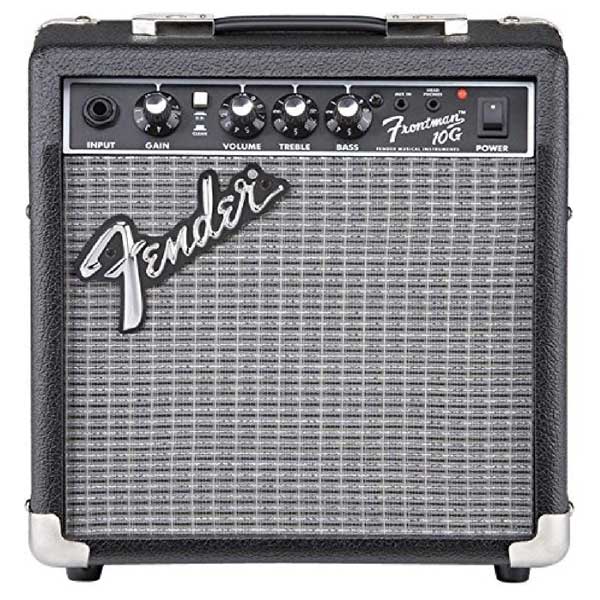
| Estimated Price | $70 |
| Dimensions | 280 x 260 x 146 mm, 3.8 kg |
| Speaker | 1×6″ |
| Output Power | 10W |
| Type and Power Supply | Solid state, power cable, no batteries |
| Input/Output | Instrumental jack, aux in, headphone output |
| Knob Panel | Gain, switch button, volume, treble, bass, power switch |
My Review: You have probably come across this amp many times before and you roughly know what it’s all about. Compared to all amps so far, this Fender amp falls behind, by far.
So why is it on this list? One simple reason, the Fender Frontman 10G is the most popular guitar amp for beginners, and it really deserves this status. The amp has the standard recognizable Fender look with skirted knobs, silver grille cloth, and a black frame.
Its price is low because it is a small solid-state amp. Plus it usually goes in a beginner combo package with a guitar, a guitar strap, a cable, picks, etc. The reason is simple, it is very cheap and small, which makes it suitable for even the youngest beginners.
Measuring 280 x 260 x 146 mm and weighing 3.8 kg, it is easy to carry from one place to another. Although it does not run on batteries (which reduces mobility) it has all the other features of a solid amp for home practicing. It has a standard 1/4 instrumental jack input, an aux-in for backing and play-along tracks, and a standard and useful headphone output.
The front panel is clear and simple. Looking from left to right they are Gain, Clean/Drive button, Volume, Treble, Bass, and a power switch.
Related Article: Our Favorite Guitar Tuners
8. Laney Mini Lion (Best Under $50)
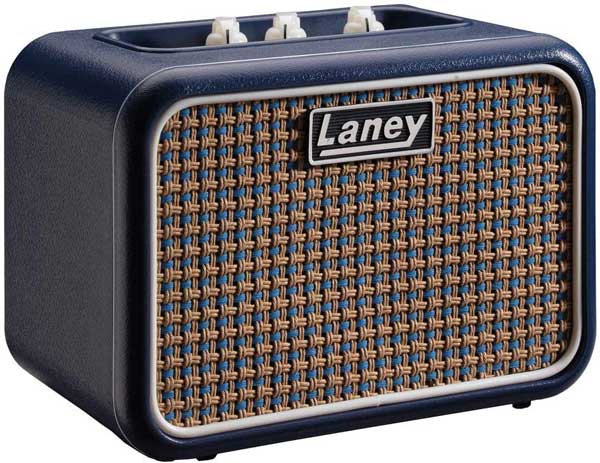
| Estimated Price | $40 |
| Dimensions | 173 x 100 x 120 mm, 1 kg |
| Speaker | 1×3” |
| Output Power | 3W |
| Type and Power Supply | Solid state, Mini-Laney power adapter, 6 AA batteries |
| Input/Output | Instrumental jack, aux in, LSI, headphone output |
| Knob Panel | Gain, tone, volume |
My Review: The Laney Mini Lion is a good example of an inexpensive, nicely designed, and original amplifier. The dimensions of this amp are 173 x 100 x 120 mm and it weighs 1 kg, which makes it an ideal desktop and practicing amp. Its maximum power of 3W comes from the 1×3” speaker mounted in an elegantly built body that looks like a retro radio.
Like all other mini amps, the Laney Mini Lion works on a power adapter when it has access to electricity or on 6 AAA batteries as an alternative when playing outdoors or on the road. The reason for the low cost and lack of guitar effects is that this is a solid-state amp. Now let’s look at the knob panel.
Here, besides the most basic gain, tone, and volume knobs, there is another feature that makes the amplifier unique, and that is the LSI, or more precisely, the Laney Smartphone Insert. It is an output that works best with iOS devices but also supports Android systems. Basically, it is an output that connects the amp to the “Tonebridge” app.
This Ultimate Guitar’s app gives you access to thousands of presets made for a wide range of songs and styles. So with help from your device, you can transform your solid-state amp into an amp with a bunch of original sounds from famous songs and artists. The app is easy to use and selecting amp presets and effects can be a very fun process. In addition, you can also make a list of sounds that will give you easier access to the original amp and effects sounds. Well done, Leney!
9. Orange Crush Mini
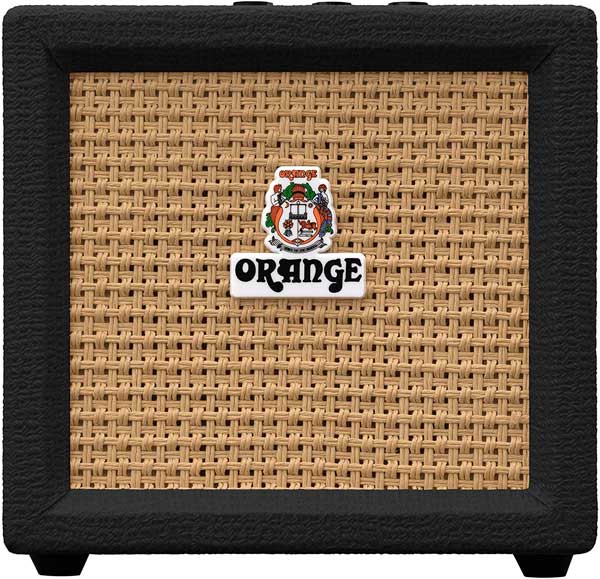
| Estimated Price | $70 |
| Dimensions | 149 x 139 x 80 mm, 0.8 kg |
| Speaker | 1×4” |
| Output Power | 3W |
| Type and Power Supply | Solid state, DC adapter, 9V battery |
| Input/Output | Instrumental jack, aux in, external speaker output, headphone output |
| Knob Panel | Gain, tone, volume, built-in tuner |
My Review: This amp is a direct competitor to the Laney Mini Lion especially in terms of size, weight, power, and price. It has dimensions of 149 x 139 x 80 mm, and it weighs 0.8 kg. Before we really get into the specifics of this amp, for all those who are not familiar with the brand I can say that the Orange amps are a great manufacturer that is very reliable and offers great blues models.
Although the output power is 3W, it comes with a 1×4” speaker, which in terms of size could be more powerful. It is a solid-state guitar amp that works on a DC adapter or a 9V battery that lasts up to 12h.
Although in the input/output section the options are standard, this amp also has an external speaker output for connecting to a more powerful speaker which is a good option to have if you even need to use this amp on a stage.
Standard in and outputs include the instrumental jack, the aux-in, and the headphone output.
The knob panel is also very simple with gain, tone, and volume plus a built-in tuner. The amp has no on/off switch and is activated just by inserting the input jack. And as its last feature, the design of this Orange Crush Mini has the standard and original look, recognizable for all other Orange models.
Related Article: Our Favorite Guitar Straps
10. Monoprice 611705 (Best Mini Tube Amp)
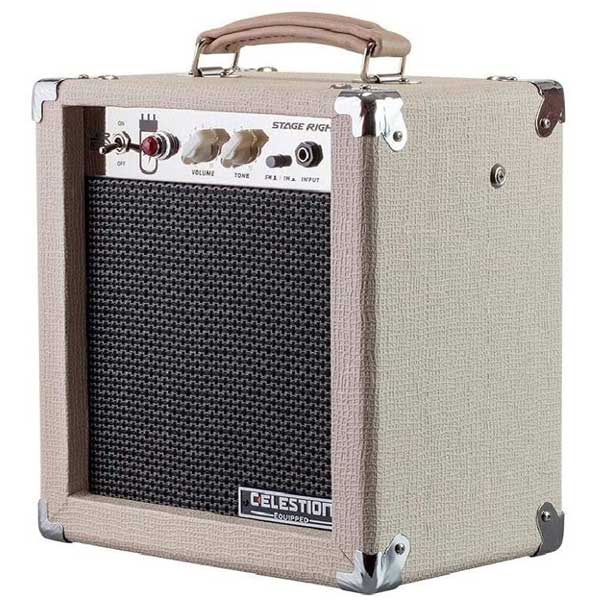
| Estimated Price | $115 |
| Dimensions | 305 x 310 x 210 mm, 6 kg |
| Speaker | 305 x 310 x 210 mm, 6 kg |
| Output Power | 5W |
| Type and Power Supply | Tube, power cable |
| Input/Output | Instrumental jack high and low |
| Knob Panel | Volume, tone |
My Review: Now here is something different when it comes to mini amps. This amp is ideal for all tube fans.
The Monoprice 611705 is the smallest and the cheapest tube amp on the market. Compared to the previous amps, this tube amp is the largest and heaviest, but for a reason. With dimensions of 305 x 310 x 210 mm and weighs 6 kg, the guitar cabinet houses an 8” Celestion Custom speaker with 5W output power.
This speaker is very specific and is often used as part of other more expensive tube amps. In the preamp section, there is one ECC83/12AX7 preamp tube, and in the power section, there is one 6v6GT power tube that produces the natural and unpredictable sound which is specific to the tube amps.
The amp does not run on batteries and is not a good option for playing outdoors. But the amp is lightweight and can be easily carried by hand from one place to another. This is great when you want to go to a friend to jam and you do not want to compromise the warm tube sound.
The amp also has an option to limit the power so it can be limited to 1W. This is good if you want to have a fresh clean sound without the natural distortion. The knob panel is very simple.
It has the high and low canal guitar input, the on/off switch, the volume, and the tone. Here the tone knob is a balance between bass and treble that is controlled by turning from left to right. Simple as that.
11. Danelectro N-10 Honeytone (Cheapest Mini Amp)
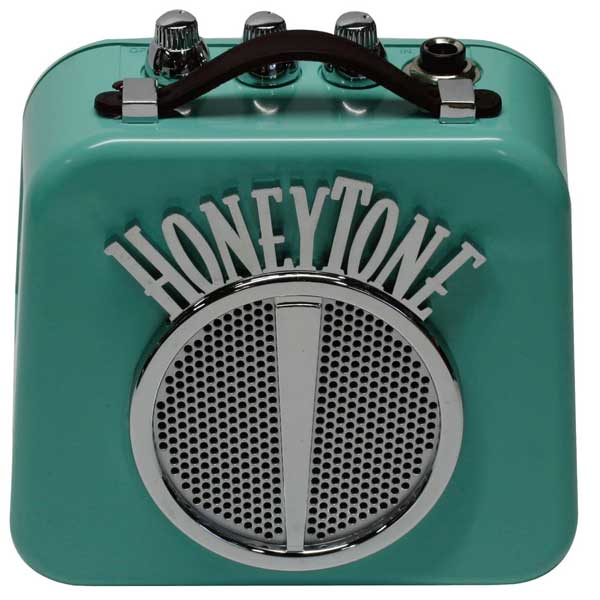
| Estimated Price | $25 |
| Dimensions | 152 x 76 x 152 mm, 0.43 kg |
| Speaker | 1×2” |
| Output Power | 1W |
| Type and Power Supply | Solid state, DC adapter, 9V battery |
| Input/Output | Instrumental jack, headphone output |
| Knob Panel | Off/volume, tone, overdrive |
My Review: Here is the cheapest option for a mini amp. It is a micro solid-state amp with a 1×2” speaker with a total power of 1W. And the dimensions are small: 152 x 76 x 152 mm, weighing only 0.43 kg.
What makes it extra portable is the belt clip with which the amp can be easily carried wherever you go. It also has a leather handle.
Normally, in favor of portability, this amp runs on a single 9V battery or a DC adapter. The input and output are simple, instrumental jack and headphone out. The downside that makes it fall short of being a good amp for practicing is that it doesn’t have an aux-in.
But the idea is to use it more for playing instead of practicing, so it does serve its purpose.
The amp is off when the volume knob is turned all the way to the left. One move to the right turns it on and then increases the volume. The second knob is the tone knob, and the last one is for turning on and controlling the overdrive. What gives this amp an extra character is its unique design. It is characterized by its specific aqua color and a beautiful vintage look.
Related Article: Our Favorite Electric Guitars Amps Under $1000
12. Vox Pathfinder 10
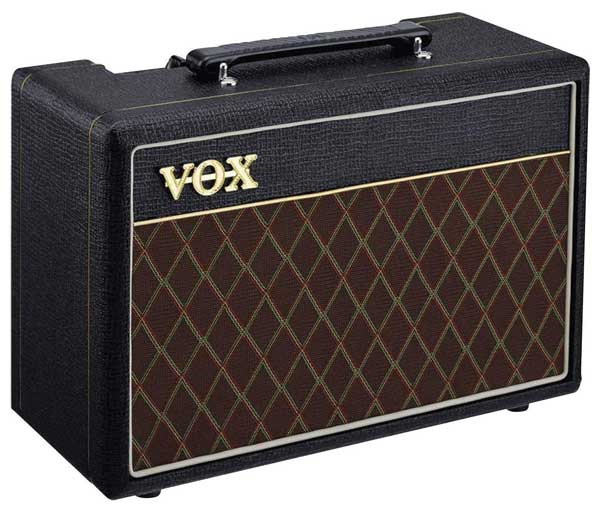
| Estimated Price | $150 |
| Dimensions | 380 x 260 x 170 mm, 4.8 kg |
| Speaker | 1×6.5” Vox Bulldog speaker |
| Output Power | 10W |
| Type and Power Supply | Solid state, power cable, no battery |
| Input/Output | Instrumental jack, headphone/rec. output |
| Knob Panel | Gain, treble, bass, volume |
My Review: Here is another Vox model. But this one is made to serve a different purpose. The Vox Pathfinder 10 is a super amp for jamming with other musicians and recording. The amp is easy to transport because it does not take up much space (380 x 260 x 170 mm) and is quite lightweight (4.8 kg).
The output power is 10W, which is solid for an amp of this size. The sound comes out through a 1 x 6.5” Vox Bulldog speaker, specially built for Vox amps. This solid-state type of amp is powered by a power cable, which is limited to use only in an indoor environment (home or a studio). There is a standard instrumental jack input and a headphone output. The same output can be used for recording.
However, to record with this amp, it will need extra effect pedals because the options for different sounds and effects are limited. The knobs on the knob panel from left to right are: gain, clean/overdrive button, the treble, and the bass knob. The last knob is the volume, and then on the right, there is an on/off switch.
13. Marshall MG10
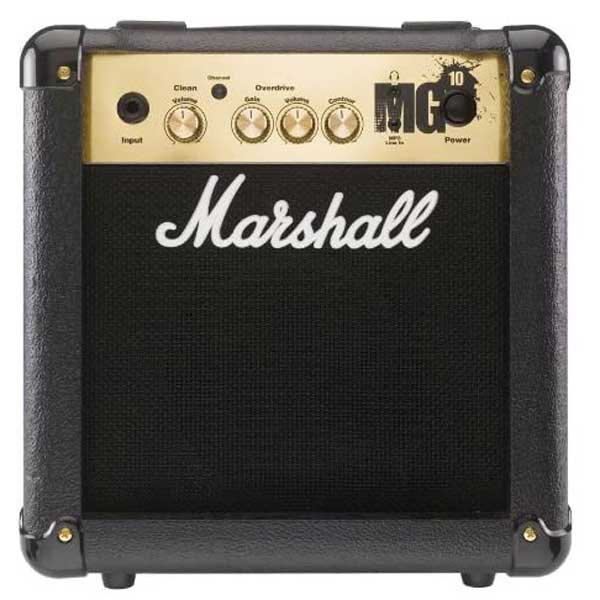
| Estimated Price | $110 |
| Dimensions | 296 x 314 x 175 mm, 4.8 kg |
| Speaker | 1×6.5” |
| Output Power | 10W |
| Type and Power Supply | Solid state, power cable, no battery |
| Input/Output | Instrumental jack, audio-in, headphone output, line out |
| Knob Panel | Clean volume, gain, volume, contour |
My Review: The Marshall MG10 is one of the most obvious rivals to the Vox Pathfinder 10 for several reasons. The dimensions (296 x 314 x 175 mm) of the two amps are almost the same, and the same goes for the weight of 4.8 kg which is exactly the same. This is a solid-state amp with a 1×6.5” speaker and with a total output power of 10W. This makes it very portable.
The line out makes this amp good for gigs and rehearsals with the band, but only if you happen to have a bigger speaker or a sound mixer control. This way you are not sacrificing the original Marshall tone. The amp has no batteries so it is best to keep it at home or in a studio. It is also good for practicing due to the aux-in and the headphone output.
A big downside is that it doesn’t have reverb (as with all other amps that do not have reverb). Without it, the sound usually sounds drier and duller. But with the right placement of the other knobs and an extra pedal, a phenomenal Marshall sound can be achieved.
The knob panel is simple: the clean volume is located on the left. In a separate section there is the gain and the volume for the overdrive, on the spot that is usually reserved for the tone is the control knob. And all the way to the right is the power switch. The amp comes in two color variants: the standard Marshall black and gold, and a black and silver option. This is easily one of the best mini amps out there.
14. Vox Amplug 2 AC30
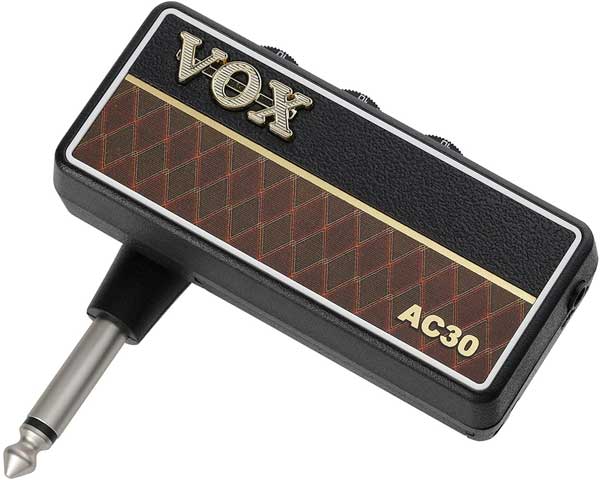
| Estimated Price | $45 |
| Dimensions | 86 x 31 x 80 mm, 40 g |
| Speaker | – |
| Output Power | – |
| Type and Power Supply | 2xAA batteries |
| Input/Output | Instrumental jack, aux-in, headphone output |
| Knob Panel | Gain, tone, volume, chorus, delay, reverb |
My Review: Here is something very different. This is an amp that you will definitely not even feel that you are carrying with you. It weighs only 40 g, which by itself is amazing, and the dimensions of 86 x 31 x 80 mm make it smaller than your phone. Its size does not allow it to have a built-in speaker, but there is a solution for that as well. Using the correct jack, the headphone output can also be used to connect it to another amp, speakers, or headphones, depending on your needs, of course.
This modeling amp runs on two AA batteries that can last up to 15 hours of active use. The guitar connects with an Integrated 6.3mm jack for direct connection which saves a lot of space plus it would not be the end of the world if you forget the cable at home. This amp is ideal for practicing due to the aux-in for adding extra tracks to play along and a headphone output so it can be used virtually anywhere.
The amp also allows the possibility of using multiple effects, namely three: chorus, delay, and reverb. There are four knobs, one for gain, tone, volume, and one for the rest of the effects.
Looking at the name of this amp it is obvious that it is an imitation of the legendary model of Vox, AC30. Besides the Vox Amplug 2 AC30, there are four other models: blues, clean, lead, and metal. So choose wisely.
15. Harley Benton Rockplug
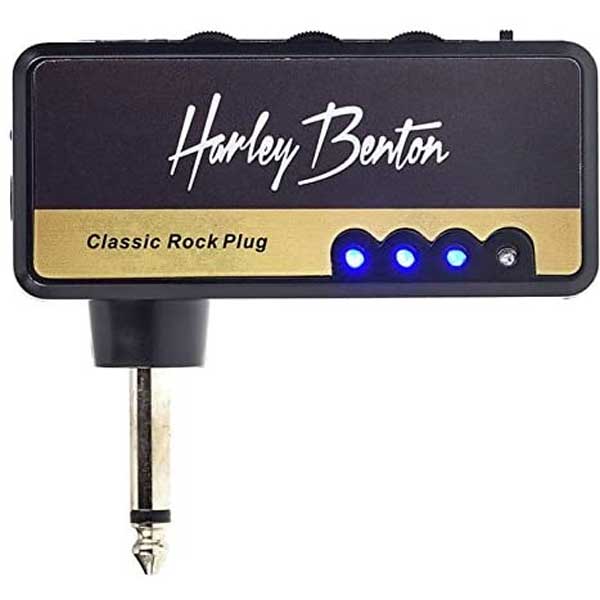
| Estimated Price | $15 |
| Dimensions | 80 x 30 x 15 mm, 50 g |
| Speaker | – |
| Output Power | – |
| Type and Power Supply | Built-in rechargeable battery |
| Input/Output | Instrumental jack, aux-in stereo, headphone output, charging mini USB port, adapter for connecting 2nd headphone set, usb |
| Knob Panel | Drive, tone, volume |
My Review: The Harley Benton Rockplug Classic Rock amp is cheaper and in my opinion a better replacement for the Vox Amplug 2. Let’s focus first on the common features in which the Harley Benton is equal with the Vox Amplug 2, and then we will focus on the advantages that this amazing device has. The dimensions are very similar (80 x 30 x 15 mm), with a very minimal difference that is frankly imperceptible. The same goes for the weight because there is only a 10 g difference. A small advantage that the Vox Amplug has is the effects.
However, the Harley Benton Rockplug has a built-in rechargeable battery that lasts up to 15h.
The great thing is after your battery runs out, there is no need to bother buying new ones or recharging the old ones. Simply plug the USB cable on the charging mini USB port.
To always know how full your battery is there is also an LED indicator.
In addition to the instrumental jack, the standard aux-in, and headphones-out, this amp also has an adapter for connecting a second headphone. There are three control knobs, drive, tone, and volume. Another perk is that the Harley Benton Rockplug has an analog overdrive circuit.
16. ZT Lunchbox Junior
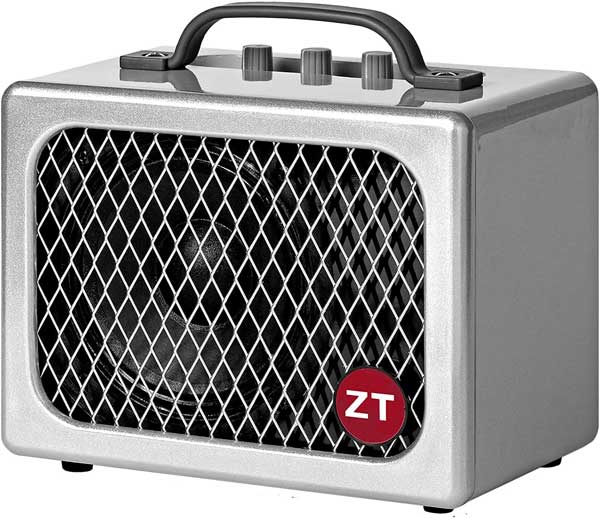
| Estimated Price | $200 |
| Dimensions | 197 x 112 x 165 mm, 2.3 kg |
| Speaker | 5” ZT custom speaker |
| Output Power | 35W |
| Type and Power Supply | Solid state, electric cable, 12V DC in, 12V ZT battery, car adapter cable, 9V power out for pedals |
| Input/Output | Instrumental jack, aux-in, headphone output |
| Knob Panel | Volume, Tone, gain |
My Review: Jazz musicians, here’s an amp for you. Looking at the specifications above this amp sounds impressive. It is a loud mini portable amplifier that can be used wherever you are, even in a car without consuming the battery. Imagine, an amp measuring 197 x 112 x 165 mm, and weighing just 2.3 kg can have an output power of an incredible 35W.
This power comes from the unique 5” ZT custom speaker. The power supply has three options: using the power cable for playing at home, in a studio, for recording and even playing gigs. And then the second option is using the 12V battery so you can perform outside. As an extra option is the 9V output power for your pedals (loop, if you ask me). And the third option is a car adapter cable if you want to practice while traveling and at the same time not use the battery.
Like most of the amps on this list, the ZT Lunchbox Junior has aux-in for audio files and headphone output for silent practicing. The great warm and mellow sound is controlled through a simple knob panel that has three knobs: volume, tone, and gain. At the back of the amp are the power switch and the speaker on/of switch.
17. Roland Mobile Cube
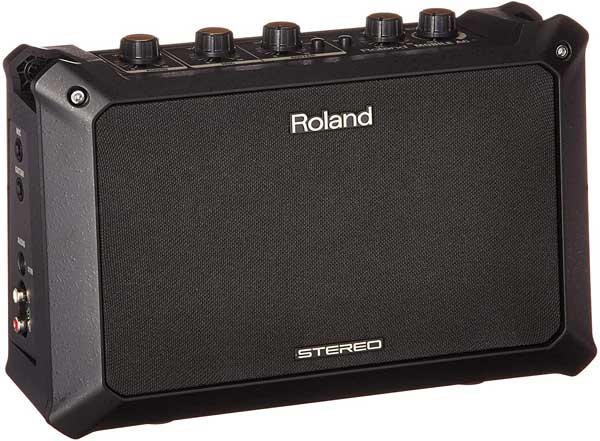
| Estimated Price | 180 |
| Dimensions | 280 x 108 x 177 mm, 2.5 kg |
| Speaker | 2×4” |
| Output Power | 5W |
| Type and Power Supply | Solid state, 6xAA batteries, DC adapter |
| Input/Output | Microphone jack, 2xinstrumental jack (keyboard, guitar, bass guitar), 2xaux-in |
| Knob Panel | Volume, stereo input selection, volume, chorus button, tone, delay/reverb |
My Review: This is a complete package for you and your family, friends, and bandmates. Although it has two 4” speakers with a total power of 2×2.5W, the amp has quite small dimensions of 280 x 108 x 177 mm and weighs only 2.5 kg. It is super portable because it is powered by a DC adapter or 6 AA batteries. An extra accessory to this amp is the carrying strap.
What makes it different from the other amplifiers on this list is that the Roland Mobile Cube is not exclusively a guitar amp. You can plug in a microphone, keyboard, guitar, and bass guitar.
This is ideal if you play multiple instruments. So you do not have to carry a different amp for every instrument. There are two aux inputs, one single and one dual so there is an option to connect two audio devices or with two different aux jacks.
The knob panel is on the top of the amp and is very simple and clear. Looking from left to right, first, there is the microphone volume, then two knobs, one for selecting an instrument and one for volume. At the far right are the tone and the delay/reverb knob. The Roland Mobile Cube is great for practicing any instrument, street performance, or singing and playing outside.
Choosing the Right Mini Guitar Amp (Buying Guide)
There are amplifiers of different sizes, for different guitars and styles, principles of operation, effects, and imitations, So the chances are that all that stands between you and your perfect amp is a bit of research.
Let’s look at what the options are specifically for mini guitar amps and what you should pay attention to before buying.
Do I Need an Expensive Mini Amplifier?
Every time we enter a store for musical instruments we already have a certain budget in mind that we are willing to spend. So of course, one of the first things you are going to ask about is the price of the product. As a beginner, it is normal for the budget to be smaller. And with a smaller budget, there are fewer options.
Most low budget amplifiers have about the same quality or options. But even with cheaper guitar amps, there are good models that stand out from the rest. The price of these products is always dictated by their brand, so when you buy a Fender, Vox, or a Marshall amplifier you will pay more but you will have a guarantee for good sound.
However, technological progress has given a boost to less branded manufacturers to reach quality but at a significantly lower price. That is why you will meet guitar amps that have a similar price but differ greatly in power, size, effects, etc.
My advice when it comes to cheaper amps always look for and research lesser-known manufacturers (lesser-known brands) because sometimes they offer much more for the same amount of money. On the other hand, if you decide to spend more money on a more expensive amplifier as a permanent solution, do not skimp. In this case, a cheaper option can be found as well, but it might be a 50-50 chance that you end up with a quality product.
What Size and Weight Should I Choose?
Customer needs have led guitar amps manufacturers to produce a variety of models. This mostly depends on the environment in which it is used.
So it makes sense to use the largest amplifiers in the studio or at home, but not so much on a gig. They have a very high quality and powerful sound, so they are usually played in concerts where there is a large stage, so the size is not a problem. Their size and weight also make them more difficult to transport and take up more space, so they are not very practical if you travel constantly.
Medium-sized amps are much easier to use outside the home, rehearsing, playing live gigs, and exercising. They are good for playing in bars because they do not take up much space in the vehicle or on stage, and their dimensions allow them to have an output power of at least 50W, which is the minimum to be used in combination with the rhythm section. However, these amplifiers compared to the larger ones have lower sound quality because their power does not permit a lot of room to balance the sound and the volume.
Lastly, the mini guitar amps are here for anyone who is not into the previous two types or already owns one (or two) of them. The main purpose of these amps is for practicing and playing outdoors and their main perk is that they are very portable. They are small and light so you can easily take them with you wherever you go. This way you can play constantly and stay in shape. What makes them ideal for practicing are the extra features that make practice easier and more interesting.
This includes a USB connection, aux input, headphones, multiple effects, recording options etc. In addition to practicing, the mini amps are the best choice for any street performer. Almost all mini amps run on batteries so you do not have to worry about where you want to stop and perform.
How Important is the Volume?
The size greatly affects the volume, and the volume affects the sound quality. Larger amplifiers are more powerful, leaving more room for manipulation of volume and sound quality. The ideal volume for producing quality sound is usually found when the volume knob is set between 2 or 3.
What happens with smaller amps when trying to reach loudness to catch up with other instruments or on a gig, while the volume increases, the sound loses quality. This applies to almost every device. The louder it is, the more it is strained and eventually, it will break faster.
With amplifiers, the first thing to go is the speakers.
But the need for loud volume is mostly for live performances, gigs, and concerts or band rehearsals. For playing and practicing at home or in a quiet environment the mini amps are more than enough. They have more options for using headphones or USB connections with your computer or other devices so the volume and power of the speakers are not crucial.
Why Should I Buy Tube Amp?
This is the oldest type of amplifier and although it is “ancient” technology, they are still among the most sought after on the market and the most popular among fans of good guitar sound. These amps produce the sound through the tubes that receive the electric signal from the guitar and then they amplify it.
The tubes are not perfect units so the sound is very organic, natural, and soft. By increasing the amp, the tubes create a natural distortion and the sound is amazing.
But the tubes heat up and wear out with time and use. They also need to be preheated to a certain degree for the amp to start producing the sound. This means that, even after the amp is turned on, the tubes need a few minutes to warm up and start processing the signal and producing the sound.
That’s why there is a “standby” switch on them that deactivates the speaker but the amp stays on to keep the tubes warm. This way you do not have to wait before playing. As a solution for overheating, the body of the amp is large enough to have more ventilation and space to reduce overheating.
The size also brings weight so these amplifiers are not a good option for performing and playing gigs. But they still remain ideal amps for recording music in the studio or for playing concerts. Recently, several tube models have appeared on the market that fall into the category of “mini” amps, a few of which we will take a look at later.
Why Should I Buy Solid-state Amp?
These amplifiers were a temporary solution to the problematic tube amps. Although the principle of sound production is the same (the amp registers the electrical signal and converts it into a sound wave), the difference is in the parts that make the sound. With solid-state amps, this is done by the transistor circuit.
In these amplifiers, the parts from which they are made take up significantly less space than the tube amps. Therefore the solid-state amps are smaller compared to the tube amp with the same power. Although when it comes to power, size, and weight, the solid-state amps might sound ideal, still their sound can not be compared to the tube.
The reason is simple, the sound produced by the transistor is perfectly accurately measured in frequencies. That is why it is flat and does not have the natural sound waves that the tube amp is capable of producing.
But in some cases these amplifiers are irreplaceable. They are physically very durable because the parts are simply built, are stronger, and more compact. When using a solid-state amp you are free to relax and not think about whether it will be damaged or broken during transportation or when you up the volume. This makes them ideal for constant travel and playing live gigs and rehearsals.
A big advantage that the solid-state amps have over the tube amps is that the solid-state amps do not need time to warm up before they start producing sound. In the case of solid-state amps with a simple press of the on/off switch you are ready to go.
Why Should I Buy a Digital/Modeling?
With the rapid technological progress in this area, the modeling amps are getting better and it will not be long before they take over from the tube amps. Before getting to know the modeling amps in more detail I too was skeptical. I personally did not expect something so “artificial” to simulate such an original and natural sound.
Although not yet at the right level, the modeling amplifiers are slowly starting to catch up with the best tube amplifiers. Proof that they are moving in the right direction is that there are modeling amps that are produced by companies such as Fender or Vox, which are already manufacturers of some of the best tube amplifiers.
The sound they produce mimics the unpredictability of the tubes and their natural distortion. But the plus side is that all the problems we usually encounter with the tube amps are excluded when we are talking about modeling amps. There are no heating tubes here so the amplifier can start as soon as it is switched on.
The system that produces the sound is small and does not take up space, and therefore doesn’t add too much weight. And they have imitations of many different models of the most famous tube amps plus all the most famous and most used guitar effects. This already looks like a perfect amplifier. However, when buying a modeling amp, it is worth investing in more expensive manufacturers and models.
Best Amp for Every Style?
Each style of music is recognizable by its original sound, so it is no coincidence that there are many different models of amplifiers. The amplifiers and their purpose were determined by the most famous guitarists and bands that left a mark on a certain style of music.
Your guitar idol is a very big factor in choosing guitars, amps, and effect pedals. So choose the amplifier that best matches the music you listen to and want to play. Let’s look at a few examples of amplifiers that suit a particular style or genre according to their most popular users.
- Vox is a leading manufacturer of guitar amps because of their consistency, something
they have proven time and time again. This is a versatile amp that is the first choice of many blues, jazz, and blues/rock musicians. They gained their popularity through the endorsement of several guitarists, including Ritchie Blackmore, Queen’s Brian May, and U2’s lead guitarist, Dick Evans.
- Marshall (in my opinion) is the most legendary manufacturer of guitar amplifiers when it
comes to rock and hard rock music. This does not necessarily mean that it is the best, but still, to get a true picture of what kind of amplifier it is, take a look at the long list of names in rock and roll culture that are supporters of this brand, such as, Jimi Hendrix, Jimmy Page, Tom Morello, and of course, Slash.
- Fender is another manufacturer of incredibly good amplifiers.
Unlike the previous two, the Fender amps are designed for virtually any type of music. Since these amps have existed for a very long time they have been played by jazz, blues, and rock musicians alike with some big names to back up the brand.
The best examples would be Stevie Ray Vaughan, Jeff Beck, George Benson, and Joe Bonamassa. This is just a very short list of my favorite amplifier manufacturers based on purpose and style. Naturally, there are several other very good amplifiers that deserve to be found on this list so we will take a look at them below.
Do I Need a Portable Amp?
When choosing an amplifier for guitarists who are constantly traveling and always want to have the option of playing and practicing, portability is a very big factor. This is especially important when looking for an amp that will work for band rehearsals, small gigs, playing outdoors, or for practicing at home or on the road.
The best amps for this purpose belong to the category “mini amps”. They usually have fewer options for setting treble, bass and middle, reverb, and overdrive. But if you invest in a quality modeling amp with all the most important features (aux-in, headphones outputs, USB connections, recording, etc) you can get a phenomenal amp that will last. These amps are, of course, small, and they might not be the most powerful amps, but you will find that they are loud enough to fulfill their purpose.
Do I Need Battery-powered Amp?
The battery-powered amps are very useful when you want to play wherever you are.
This is especially important for street performers who rarely have the opportunity to supply their gear with electricity. While the ability to run on batteries is a big advantage, it is just as important to have the option of an adapter or power cord.
With constant use, the batteries wear out and need to be constantly replaced or recharged.
Most batteries last between 12 and 15 hours of active use. This is good if you use the amp outdoors. But while you are using it at home and have access to electricity, it makes the most sense to plug the amplifier into an electrical outlet.
What Guitar Effects Do Amps Have?
The most basic control knobs in amplifiers are the equalizer (treble, middle, and bass), the reverb, and the drive knobs. These options are found in the tube and solid-state amplifiers. With the mini amps, it often happens that they are limited, usually at the expense of the middle and the reverb control. But the new modeling amps are a different story.
With modeling amps, in addition to the most basic options, there are also various preamps of already known and popular models. Next to them, there is a whole section that houses the most used guitar effects such as reverb, distortion, delay, flanger, and chorus. The quality of these effects cannot be compared to analog guitar pedals. But when you take a look at the price, they are not to be underestimated.
The way these effects work is very simple and they are selected through a single knob.
For certain effects, such as the delay, three knobs are mainly used, time, feedback, and volume. If there is less space on the knob panel (especially with the mini amps) a simpler variant is tap to set the delay.
How to Choose the Best Mini Amp for Practicing?
Practicing the guitar for many guitarists is a daily aspiration and even need. It’s about staying in shape, learning songs, or recording music. But hardly anyone can be in the studio or in a practice room for long periods of time. Every day we waste a lot of time waiting for transportation, during work breaks or long trips. And if you have the right guitar gear you can use it this time.
That’s why you need a mini amp for practicing wherever you need it, which you can put in a backpack or even in your pocket. And it would be ideal if it had a headphone output so that you would not disturb your family or neighbors if you stay up practicing in the late hours. Another feature that a good practice amp must-have is the aux input through which songs can be played for learning or backing tracks to play along.
And as an extra feature that would complete the best practice amp is a recording output through which you can record and save all the ideas that come to you while playing.
Can I Use a Mini Guitar Amp for Gigs?
There are a few things to keep in mind when choosing the ideal guitar amplifier for gigs.
First, you need an amp that will be loud enough to match the rhythm section, especially with the drums. The ideal power for this purpose is about 60 watts. Anything below 60 watts should be played much louder to balance with the band, which is not good for the amp.
Amplifiers with this power are usually made with a 1×8” speaker or bigger which means it no longer belongs to the mini amp category. So if you want to carry a more powerful amp it will cost you a lot of space and weight. Therefore, for playing gigs, you can not use a mini amp.
And last but not least, do not wear tube amps on gigs.
The reasons are simple, compared to the solid-state or the modeling amps they are heavier, bigger, and more fragile, and then they need time to warm up. But still, to be fair, nothing can replace the tube sound so if some gigs mean a lot to you, feel free to bring your favorite amp.
What Extra Features Should a Good Mini Amp Have?
When it comes to functionality, the latest models of guitar amps (whether small or large, but mostly digital) have many features that make practicing and playing much easier than some older models. Among the first important features of the guitar amp is the aux input. This input connects devices (such as phones, tablets, etc.) using an aux cable through which audio exercises, songs, or backing tracks can be played.
The next thing a good amplifier should have is a headphone output. This is ideal for practicing anytime, anywhere without bothering other people. One of the most useful things you can find in amps is the USB connection for recording on your computer.
This means that the amplifier is connected through a special recording software with your computer. This allows you to make and record your original music through the amplifier and its effects.

My name is Chris and I’ve had a passion for music and guitars for as long as I can remember. I started this website with some of my friends who are musicians, music teachers, gear heads, and music enthusiasts so we could provide high-quality guitar and music-related content.
I’ve been playing guitar since I was 13 years old and am an avid collector. Amps, pedals, guitars, bass, drums, microphones, studio, and recording gear, I love it all.
I was born and raised in Western Pennsylvania. My background is in Electrical Engineering, earning a Bachelor’s degree from Youngstown State University. With my engineering experience, I’ve developed as a designer of guitar amplifiers and effects. A true passion of mine, I’ve designed, built, and repaired a wide range of guitar amps and electronics. Here at the Guitar Lobby, our aim is to share our passion for Music and gear with the rest of the music community.

I’m so glad to see that there are still some great mini guitar amps available in 2022! I’m currently using an amp that is about the size of a pack of cigarettes and it works great for me.
I’m so glad to see that there are still some great mini guitar amps available in 2022! I’m currently using an amp that is about the size of a pack of cigarettes and it works great for me.
Thanks for this article. Would you mind sharing why you left the Spark MINI out of this list? It gained so much popularity recently! Not warranted?